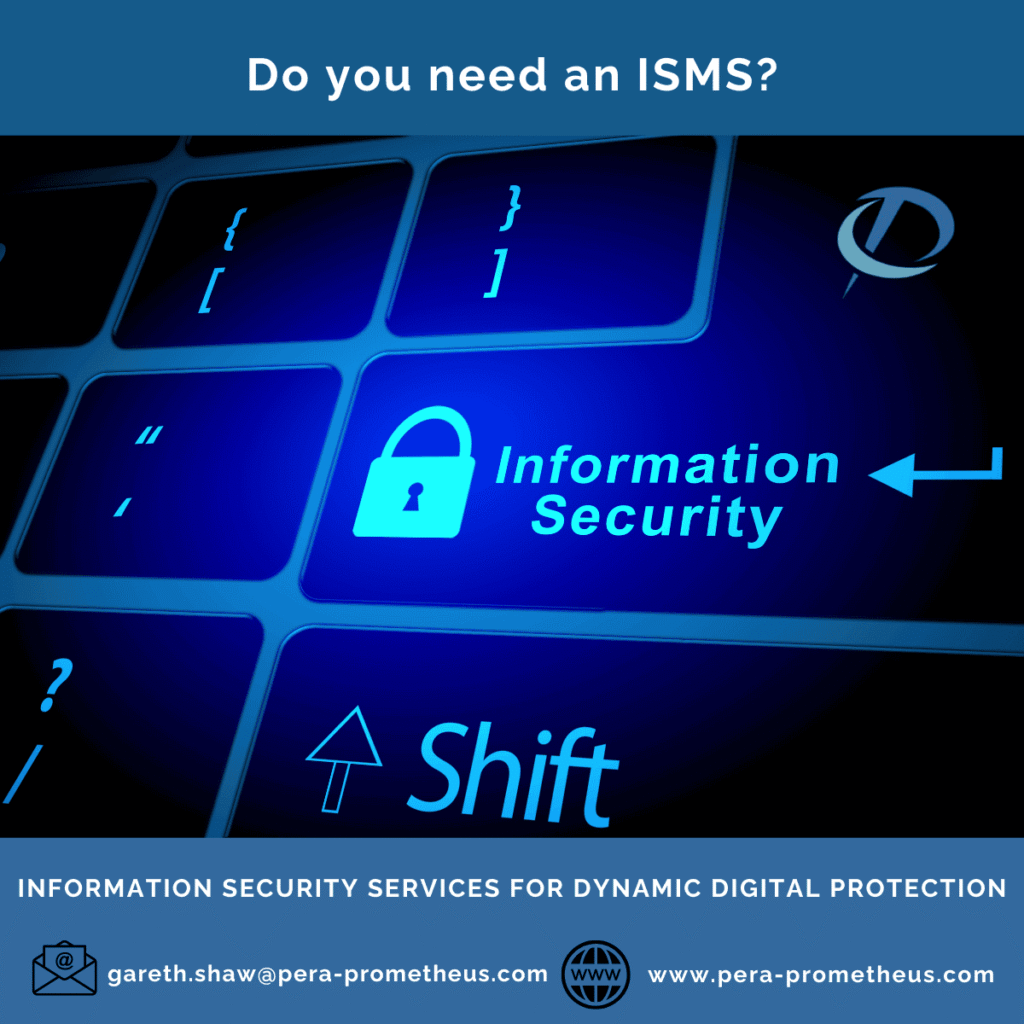Table of Contents
Information is one of the most valuable assets for any business. Whether its customer data, financial records, intellectual property, or confidential information, keeping this information secure is essential to maintaining trust and ensuring smooth business operations. However, managing the security of this information can be challenging, especially with the constant threats businesses face from cyber-attacks such as ransomware attacks, phishing attacks, and internal risks.
Do you need an information Security Management System(ISMS)?
Not every organisation needs to go to the length of implementing a full Information Security Management System (ISMS). If you are not sure if you need an ISMS, a Business Impact Analysis will be able to inform you.
An ISMS does however deliver great value by providing a structured framework that helps organisations protect their information assets. By implementing an ISMS, businesses can identify risks, establish effective access controls, and ensure that sensitive data remains confidential, accurate, and available when needed. A fully implemented ISMS will also provide trust in your organisation.
Businesses need to protect their sensitive information not only to avoid cybersecurity incidents (such as ransomware attacks and phishing attacks) but also to comply with data protection regulation GDPR. An ISMS offers a structured approach to safeguarding data, ensuring businesses stay secure and compliant. Below are some key elements of ISMS:
Key Elements of ISMS
- Confidentiality: Ensures only authorised individuals can access sensitive data.
- Integrity: Ensures data remains accurate and complete, preventing unauthorised changes.
- Availability: Ensures information is accessible when needed.
An ISMS is composed of the following ISO 27001 Clauses 4-10 and a Statement of Applicability. The ISMS main body clauses are:
- Clause 4: Context of the Organisation – This clause focuses on understanding the environment in which organisations operates, the value of organisational information assets, the risk management of those assets, and identifies organisational stakeholders and suppliers.
- Clause 5: Leadership – No Policy, Process or Procedure is worth anything if it is not actively implemented, monitored and subject to continual improvement. This Clause defines the leadership structure that endorses, implements and supports the ISMS.
- Clause 6: Planning – This clause focused on identifying information security risks associated with businesses and planning on how to manage them through effective Risk Management, Change Management and Continual Improvement.
- Clause 7: Support – Ensures that personnel will have the necessary training and support, either internally or resourced, to be able to competently deliver the requirements of the ISMS.
- Clause 8: Operation – This clause ensures that any planned processes for information security are put into action. The processes need to be tested and documented at planned intervals or after significant changes to ensure they are still effective.
- Clause 9: Performance Evaluation – Internal audit program and management reviews are the two essential components of this clause. It requires conduct of planned audit to facilitate ISMS compliance and provide opportunity for continual improvement.
- Clause 10: Improvement – This clause encourages organisations to address the findings from the internal and external audit program and implement corrective measures to strengthen the information security. It is a repeat process to ensure continual improvement.
Benefits of ISMS
Implementation of an ISMS offers numerous advantages, helping businesses operate more securely and confidently. Some of the key benefits include:
- Enhanced Cyber Security: ISMS identifies risks and implements measures to protect businesses critical data.
- Cost Savings: By preventing breaches, ISMS saves businesses from the financial impact of data loss and costly legal penalties.
- Customer Confidence: ISMS implementation builds clients trust that their data is safe, boosting company’s reputation and enhancing customer loyalty.
- Business Continuity: By safeguarding data and systems, ISMS ensures smooth operations, even after an incident or breach, minimising disruptions.
- Legal Compliance: ISMS can help businesses meet regulatory requirements avoiding fines and potential legal issues related to data protection.
A Globally Recognised Standard
An organisation holding ISO 27001 certification demonstrates that it has both achieved and maintainsa globally recognised standard, endorsed by leading authorities and professionals, in its protection of its own, and its stakeholders information. More importantly, it will take your organisation on a journey of discovery whereby you will attain a deep understanding of the value of the information that you hold and how to protect it both in the present and in the future.
Implementing an ISMS is an effective way to protect sensitive data, ensuring compliance with regulations, and building trust with customers. By addressing key elements like confidentiality, integrity, and availability, an ISMS helps businesses stay secure in the face of evolving cyber threats. Investing in an ISMS not only safeguards your business but also ensures smooth operations and long-term success.
There are however other Global and National standards which may be more applicable to your organsiation. Make sure that you understand your organsiations needs by conducting a Business Impact Analysis before committing to any one standard. A BIA will ensure that you select the correct approach for your organisation and will almost certainly save your business undue stress and expense.





